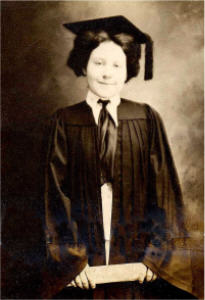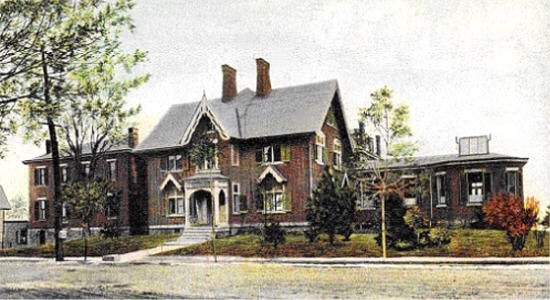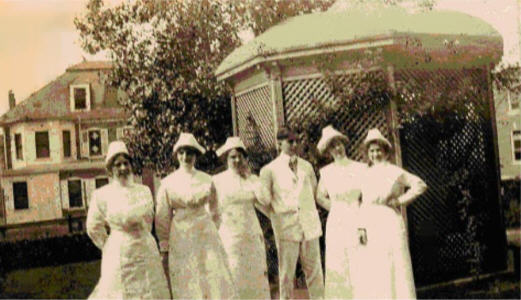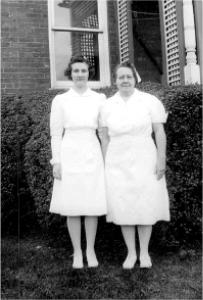A Nurse’s Journey:
The Story of Bertha Amelia Jamison Hoff (Stout)
b. October 1, 1890 – d. January 4, 1981
By Elaine Jones
Dedicated to my daughters, Alena and Katia Woods,
who never met their great-grandmother.
Back at the turn of the 20th century, there were few job opportunities available for women. One could become either a school teacher or a nurse. That didn’t matter to Bertha Hoff because all she had ever wanted to be was a nurse. It was something that she never really thought much about. She just wanted to be a nurse, and that was that.
Bertha Hoff Stout
Perhaps nursing was Bertha’s chosen profession because she looked as a nurse should look. Bertha had a kind face, and she also had a sturdy build, a definite requirement for a nurse in the early 1900s because back then the job required physical labor such as lifting patients and moving hospital beds. There were no motorized wheelchairs or electronic beds. The nurses supplied the physical power, provided the bedside care, and were responsible for keeping the patients clean and comfortable. Nurses were also responsible for the housekeeping duties in the hospital, such as washing the floors, changing the beds, and anything else that needed to be done.
There were several reasons why Bertha had her heart set on becoming a nurse. Her two sisters died early in life. Elizabeth died of epilepsy when she was fourteen years old. Mary A. W. Hoff died on February 25, 1890 at age thirteen months when she accidentally pulled a pan of boiling water from the stove onto herself. Bertha was a capable girl, and she wanted to enter medicine so she could help people as others had helped her sisters when they were in need of medical treatment. Another reason Bertha wanted to become a nurse was because a friend of hers had chosen that career path.
Bertha graduated from Phillipsburg High School in 1909 and planned to begin nurses’ training at Saint Mary’s Hospital in Brooklyn, New York. She chose Saint Mary’s because a friend of hers had graduated from there and also because she had an aunt and cousins who lived in Brooklyn. However, Bertha’s mother, Caroline, refused to allow her daughter to leave home to attend training that far from Phillipsburg. Caroline had already lost two daughters, and she could not bear the thought of her youngest girl leaving home. Consequently, instead of going to nursing school, Bertha earned a teaching certificate by completing a summer course and then taught school for one year in a one room school house in New Village, New Jersey.
In 1911 when Bertha turned 21 and was of legal age, she commenced her medical training in Brooklyn. However, her time away from home was short lived. After only two months away, Bertha received word that she must come home to Phillipsburg immediately. Her mother had become very ill because she missed her daughter so much. Bertha returned to Phillipsburg and eventually continued her training at Easton Hospital, only a few miles from home.






 Easton Hospital, Easton, Pennsylvania – early 1900s
Easton Hospital, Easton, Pennsylvania – early 1900s
The nursing education of the time was based on the Florence Nightingale model, an organized way of teaching nursing that led to advancements in medical and surgical practices. These improved hospital sanitation and reduced mortality rates. The training consisted principally of three years of hard clinical and domestic work, associated with strict moral and academic discipline. It was a residential program and many of the young women were homesick. Most of the trainees were recent high school graduates, aged seventeen or eighteen. In addition to having to live in the nurses’ home, the students were required to attend church services, which were held every Sunday afternoon. Rules governing appearance were very strict. Nurses had to wear their hair straight back, with no curls or waves. One day, a student reported to work with her haired curled. She was immediately sent back to the nurses’ residence to wash her hair before she was allowed to assume her duties in the hospital.
The life of a nursing student was not easy; the student nurses worked hard physically, doing domestic duties while learning nursing care during their 12-hour shifts. There was little free time given for extra-curricular activities. Finally in 1914, the year that Bertha graduated, it was decided to give student nurses $8 a month for uniforms and textbooks, two weeks' vacation, two free hours daily, one free afternoon weekly, and free time every second Sunday of the month.
Easton Hospital Training School for Nurses – Class of 1914
from left to right: Elizabeth Garey, Mae Hegerty, Bertha Hoff, Dr. Schwartz,
Freda Jones and Harriet Masters
A nurse’s primary function was to provide good bedside care. They were also responsible for housekeeping duties on their units. Nurses were taught to take temperatures, pulse rates and respiration, but taking blood pressure was a task the doctors performed.
Academic studies included courses in anatomy, arterial circulation, and the skeletal system. The following questions were taken from a test that was given to the junior class on June 2, 1913:
1.Name three common remedies derived from each of the three kingdoms: animal, vegetable and mineral.
2.What would you suggest as the best time to give Epson Salts and why?
3.What would you do in case of carbolic acid and laudanum poisoning?
Nursing students were not allowed to speak to the interns. Classes were taught by the doctors, most of whom were abrupt with the student nurses. Only Doctor Green was willing to take the time to explain procedures and answer the students’ questions. The operating room experience started with picking up sponges and progressed to assisting during surgery. The student nurses were alone on night duty; there were no orderlies to assist them. If a patient died during the night shift, the nurses were very scared when they had to take the body down to the basement morgue, especially if there was already a body down there. They did not like going to the basement at night when no one else was available to go with them.
There was little need for courses in pharmaceutical medicines because there were few medicines available to dispense at the turn of the 20th century. For example, Alexander Fleming did not invent penicillin until 1928. Additionally, it was expensive to produce penicillin in the early days; it was not until the 1940s that the drug was mass produced and made available to the general public to fight bacterial infections.
Bertha met her husband, Clarence Stout while she was in nurses’ training. She was on duty when Clarence’s brother was brought into the hospital. He had been struck by a trolley car in Easton, Pennsylvania and eventually succumbed to his injuries. Later, Clarence was admitted to the same hospital for a ruptured appendix. During his stay there, his romance with Bertha progressed, and he proposed marriage. He joked that Bertha would not let him leave the hospital unless he proposed! Bertha and Clarence Stout wed on November 14, 1914, a few weeks before Bertha’s final RN training was complete. She had to conceal their marriage and wear her wedding band on a chain around her neck under her uniform because nurses were not allowed to be married while they were still in training. If Bertha’s secret had been found out, she would have been expelled from the school!
Following the completion of her training, Bertha chose not to pursue a career in nursing. She focused her energies on being a wife and then a mother. Bertha gave birth to her first daughter, Ruth, on December 21, 1916. However, Bertha was forced to return to nursing during the flu epidemic of 1918. All nurses were required to return to work but Bertha did not immediately go. Doctor Barber personally called on Bertha and commanded that she return to her profession. In October of that year, Congress approved a special $1 million fund to enable the U.S. Public Health Service to recruit physicians and nurses to deal with the growing epidemic. US Surgeon General Rupert Blue set out to hire over 1,000 doctors and 700 nurses with the new funds. The war effort, however, made Surgeon General Blue's task difficult. With many medical professionals already caring for fighting soldiers, Blue was forced to look for medical professionals in places such as old-age homes and physical rehabilitation centers; plus he ordered mothers with young children, such as Bertha, back to work. Consequently, Bertha’s mother was called upon to watch her granddaughter, Ruth.
Epidemic conditions forced churches, schools, and theaters to close, along with other public gathering places. The 1918 WW I flu epidemic killed an estimated 30 million people world-wide. One reason why the flu epidemic killed so many people was that millions of people were mal-nourished as a result of the privations of the war. The body's ability to survive a flu attack is greatly reduced without proper diet and health care. The epidemic ended on its own when it ran out of healthy people to infect.
Bertha returned to life at home and celebrated the birth of her second daughter, Carolyn, in 1921. Bertha was again forced to return to work when Clarence died in 1933. Ironically, Bertha had to petition the court for legal guardianship of her daughters! In those days, only men were considered legal guardians of children. Bertha was granted legal custody because her nursing career afforded her the financial means to support her children and because the judge was a family friend. Clarence died without a will, and all his finances were frozen, except for the money that was used for the education of his daughters. Bertha returned to nursing full-time, which required her to work six days a week in 12 hour shifts. She earned $2.34 a day; her meals were free, and uniforms were laundered at no charge. Bertha paid a neighbor $.25 a day for Carolyn’s supper. This was during the Depression and the neighbors were thankful for the money.
Bertha and her daughtor Carolyn
Bertha’s daughter, Carolyn, followed her in her mother’s footsteps and graduated from Easton Hospital School of Nursing in 1941. The training had advanced to include specialization in surgery, infectious diseases, and obstetrical care but remained focused on providing one-on-one quality bedside care. By 1945, World War II had seriously depleted the hospital staff. This led to the development of ancillary departments, such as Housekeeping and Central Services, which freed the nurses from many of the non-professional duties, allowing them to concentrate more fully on patient care.
Bertha continued to work as a nurse until her retirement in 1955. She had wanted to retire earlier, but she was forced to continue working until nurses were covered by Social Security and Medicare. Since nursing was primarily a profession for females, it was expected that nurses would receive benefits via their husbands and would not need to qualify on their own merits. Women who never married or were widows went without coverage until Congress amended the eligibility requirements in the early 1950s.
Bertha had a career and after the death of her husband, she was the sole supporter of her family during a time when this was highly unusual. She was a caring, self-sufficient woman who knew her own mind. Her devotion to education, independence, career, and family is to be admired.







